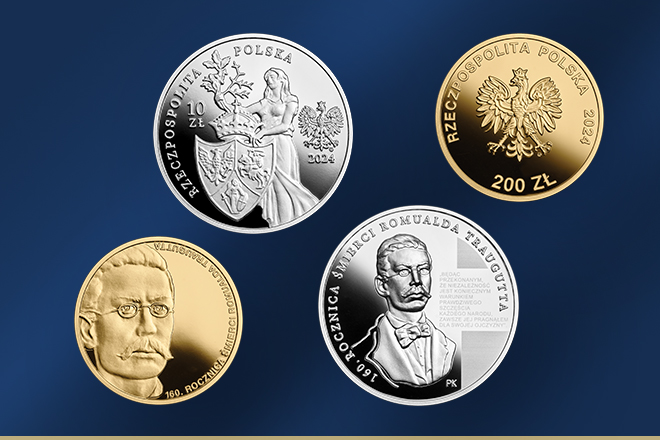“160th Anniversary of the Death of Romuald Traugutt”
Narodowy Bank Polski has issued gold and silver collector coins commemorating the last leader of the January Uprising.
Narodowy Bank Polski has announced that gold and silver collector coins “160th Anniversary of the Death of Romuald Traugutt” are available on sale as of tomorrow.
The coin with a face value of 200 złoty is made of 900 purity gold, has a diameter of 27 millimetres and weighs 15.50 grams. It has been minted in up to 1,200 pieces. The coin with a face value of 10 złoty is made of 999 purity silver, has a diameter of 32 millimetres and weighs 31.10 grams. It has been minted in up to 10,000 pieces.
The coins are sold at all the NBP regional branches and in the NBP online shop Kolekcjoner at the price of PLN 5,000 for the gold coin and PLN 340 for the silver one.
The reverse of the gold coin features an image of Romuald Traugutt. The obverse bears the regular elements: the face value, the image of the Eagle established as the state emblem of the Republic of Poland and the year of issue. The reverse of the silver coin features an image of Romuald Traugutt and his words spoken during the investigation by the Russians. On the obverse of the silver coin, a figure of a woman holding twigs with oak leaves and hawthorn stems with thorns – symbols of strength, perseverance and suffering – is presented as an allegory of freedom. Next to her image there is the coat of arms of Poland, Lithuania and Ruthenia from the January Uprising.
Romuald Traugutt (1826-1864) is one of the most recognisable heroes of the January Uprising, a symbol of struggle to the very end, of nobility and martyrdom. The first thirty-six years of Traugutt’s life did not foreshadow his extraordinary story. The future leader of the insurrection came from a family of landed gentry of modest means settled in the Grodno region. After completing gymnasium in Świsłocz, he intended to become an engineer, but when this proved impossible, he joined the Tsarist army. In its ranks, he took part in the intervention against the Hungarian uprising and in the Crimean War. Personal experiences and progressive visual impairment influenced his decision to leave the Tsarist army and settle near Kobryń.
The former lieutenant-colonel of the Tsarist army initially kept his distance from the uprising that broke out in January 1863. Not without misgivings, persuaded by his neighbours, he stood at the head of an insurgent unit. “As a Pole, I judged that it was my duty not to save myself where others sacrificed everything,” he later explained his decision. He fought bravely and with some success, but in view of the enemy’s superiority and having exhausted the possibilities of combat, he disbanded the unit, and himself, sick and exhausted, hid at the writer Eliza Orzeszkowa’s place. He then left for Warsaw, and later, under the assumed name of Michał Czarnecki, he went on a mission to France.
On 17 October 1863, Traugutt became the leader of the insurrection. Unlike the two previous dictators, Ludwik Mieroslawski and Marian Langiewicz, he headed the struggle in strict secrecy, directly contacting only a few individuals. He concentrated all his energy on financial matters, rebuilding the insurgent armed force and seeking help from Western European countries. Despite dedication and desperate struggle, the uprising had no chance of victory. Traugutt, however, remained steadfast until the end. He was arrested by the Russians at his conspiratorial headquarters, in his Warsaw flat at 3 Smolna Street. He offered no resistance and only uttered the words: “So there it is …”.
He was imprisoned in the 10th Pavilion of the Warsaw Citadel and, despite a brutal interrogation, did not denounce anyone. He was hanged on 5 August 1864, together with four members of the National Government. The execution was watched by 30,000 people. The crowd, kneeling, sang the supplication: ‘Holy God, Holy Mighty One’.
Traugutt’s indomitable attitude and martyrdom gave birth to the legend of the last dictator of the January Uprising. Another prisoner of the Warsaw Citadel, Józef Piłsudski, considered himself Traugutt’s ideological heir.
More information can be found in the brochure.
NBP collector coins and banknotes are sold in commercial packaging with an attached certificate.
The next issue was scheduled on 26 July 2024. On that date Narodowy Bank Polski put into circulation a collector note “80th Anniversary of the Outbreak of the Warsaw Uprising”, with a face value of 20 złoty.
Contact:
Contact for collectors: e-mail kolekcjoner@nbp.pl, tel. +48 22 185 17 05
Contact for the media: e-mail press@nbp.pl, tel. +48 22 185 2012
***
About NBP
Narodowy Bank Polski holds the exclusive right to issue banknotes and coins in Poland. All currency issued by NBP, including collector banknotes and coins, is legal tender in Poland. Issuing collector items is an occasion to commemorate historic figures and anniversaries as well as to develop the interest of the public in Polish culture, science and tradition. High-resolution images of the coins: https://nbp.pl/en/coins-and-banknotes/collector-coins/catalogue/
